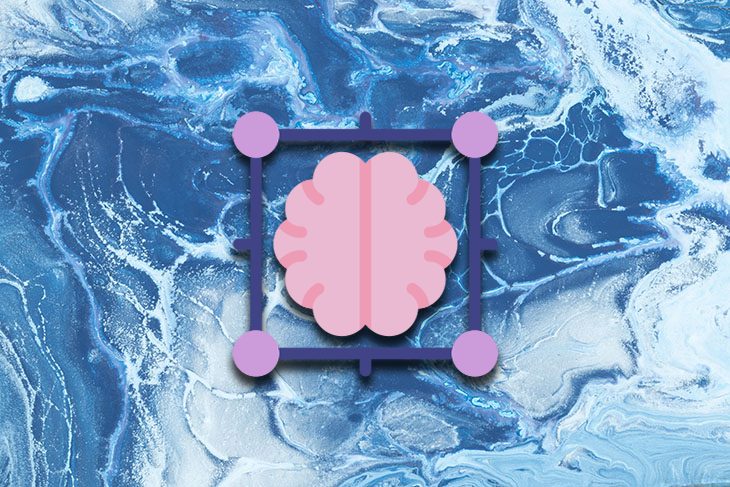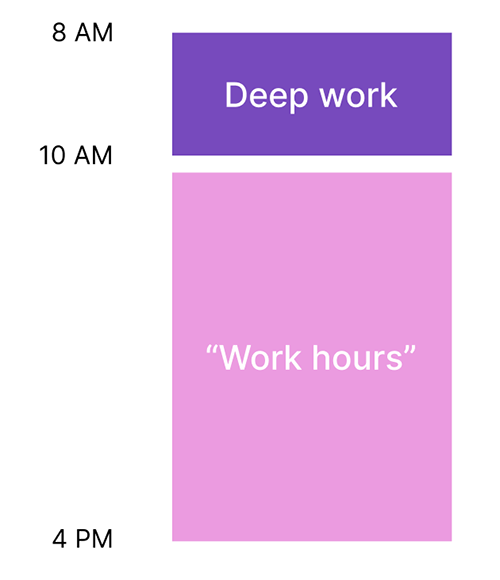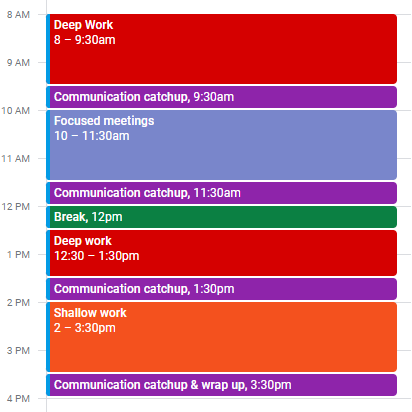Product management is a very demanding discipline. The fact is, there’s always more work to do than there is time during the day. This is why optimizing one’s personal productivity is essential to strive as a product manager. Every one percent improvement counts tremendously.

Here you’ll find a list of a few solid case practices that helped me improve my personal efficiency as a PM. Maybe some of them will be useful for you, too.
At the end of the day, it’s these small systems and daily habits, not big swings, that matter most.
I have yet to find a better “productivity hack” than this one.
If it’s possible, agree with your peers on shorter “official working hours.” For example, if you work eight hours a day, agree on six hours when you are available for others. For the remaining time, work in stealth mode.
For example, I don’t turn on Slack or accept meetings before 10 AM. However, I usually turn on my computer around 8 AM. In those two hours, I do my most important tasks for the day.

Ultimately, I start my “workday” around 10 AM, like some of my colleagues, but I already have two hours of hyper-productive work done. It also limits the surface for distractions and unplanned meetings/emergencies to six hours.
Although this approach might not be acceptable in many companies, at least give it a try.
One of the worst PM habits is to automatically accept meeting invitations. Be very strict in which types of meetings you participate in.
Especially avoid unclear meetings without an agenda. Life is too short to waste time on unproductive meetings.
Don’t let FOMO get the best of you. If you are truly needed in a meeting, people will chase you. In most cases, they won’t need to.
Product managers tackle multiple different contexts during their week. That itself isn’t bad, but the constant context-switching accompanying it is a different story.
Limiting context switching is one of the easiest ways to improve one’s productivity, and time blocking is a perfect solution.
Long story short, book some slots in your calendar when you focus on a single type of task, for example:
It should help you get into a “flow” with a given type of task, thus achieving more in a shorter amount of time.
I tried having a daily to-do list and I failed. Then I tried having three main goals a day, but I failed again. After that, I decided to focus on one highly valuable task a day, and most of the time, it does work.
Let’s face it, days are unpredictable, distractions are everywhere, and priorities change. Having robust to-do lists rarely works for a product manager.
But if you regularly don’t accomplish your to-do list, it’s easy to lose motivation and start treating these objectives as “nice-to-haves.” That lack of discipline can be pretty harmful in the long run.
An alternative would be to strive to achieve one highly valuable task a day. Just one. There’ll be days when you’ll be able to complete two, three, or maybe ten tasks like that. The important thing is to build a discipline of achieving at least one task like that no matter what happens during the day.
It helps to establish the discipline of constantly doing proactive and valuable work rather than just being dragged back and forth by external forces.
If you build this habit, you’ll complete at least 260 highly valuable activities a year. It’s actually quite a lot.
Sometimes, PMs don’t have a direct boss they have to report to regularly. Although this comes with benefits, it also has disadvantages. It’s harder to stay disciplined if no one asks you for an update.
If you are one of these people that work more effectively having an external deadline, look for an accountability partner in the company. You could meet once a week and plan your goals for the upcoming days.
In my case, the fact that I’ll have to give an update to my accountability partner in a week is a solid motivator to chase my weekly goals.
Let’s take a look at some unpleasant facts:
In short, meetings suck the life out of PMs. But assuming you can’t just escape all of these meetings, what else can you do?
Try walking.
I discovered this hack by accident. I just wanted to burn some more calories, but after purchasing a standing desk, I realized my energy levels improved dramatically.
In the past, a passive meeting was an energy sucker. But now it’s an opportunity for me to ramp up the speed on my standing treadmill and actually do some cardio while still being able to participate in the meeting if needed.
Just imagine the difference between someone sitting through a two-hour-long meeting and someone walking a few kilometers (or miles) in the meantime. Who do you think will have more energy after the meeting?
Counterproductive as it might seem, taking more breaks than you feel like might be a silver bullet to improving your daily outputs.
According to DeskTime research, the most productive people take roughly a half-hour break every two hours. That’s approximately 20 percent of their workday. But when you look at a typical PM calendar, it’s rarely even 10 percent. Seems like back-to-back meetings and trying to squeeze the most out of one’s day ultimately make us achieve less.
Not to mention that the product outcomes often depend on the PM’s creativity and problem-solving skills, and as we all know, the best ideas happen under the proverbial shower. So don’t feel bad taking a 30-minute yoga break in the middle of the day — it might be a better solution than calling another team brainstorming session.
The type of work PMs do is rarely fully “done.”
The PowerPoint slides could always be prettier, the product requirements document could always have more details, that one report could be edited more thoroughly, and so on. It’s easy to fall into the perfectionism trap.
But the Pareto principle is ruthless, and just 20 percent of our effort generates 80 percent of our results. Don’t seek the remaining 20 percent of the result. It’s not worth it.
One of the tactics to avoid perfectionism is to add acceptance criteria to bigger tasks on your plate. Whether it’s ad hoc market research or weekly roadmap review, clearly define when a task is complete, and don’t go overboard.
For example, one of my acceptance criteria for a backlog review is “are the top 15 items properly prioritized?” and it grounds me not to go overboard. There are more important things than ensuring the 49th item on the backlog is in the right place.
Communication, including sending and checking emails, answering Slack messages, writing updates, and so on, takes a lot of product managers’ time. One could say a PM is a glorified telecommunication pole and translator, and there would be a grain of truth in that.
However, there’s much more to product management than just communication, so we have to make sure we don’t get sidetracked by ad hoc messages and requests all the time.
One of my favorite tactics is to do communion in bulk. Keep your communicators offline most of the time, and process them all at once in intervals. For example, two hours off communication and a 30-minute communication catch-up.

This way, you can reap the benefits of focused work (since you are not distracted by constant communication flow) and working in batches (since you catch up on communication in bulk).
For some people, it might sound impossible to implement, but I believe it’s often a mental barrier. Very few of us are working on mission-critical medical or military software. In most cases, the world won’t end if it takes you an hour — rather than five minutes — to answer a message.
And if you are still worried and you might miss some critical emergency, agree on an alternative communication channel for cases like that. For example, I have my Slack notifications turned off (even for pings) for my messages, but my team knows that they should call me if there’s something genuinely urgent.
I hate to break it to you, but you are not indispensable, and the team will survive without you answering their messages for a few hours.
At the end of the day, the most impactful yet most difficult tactic to implement is to build and cultivate self-organized, high-ownership teams.
What might be overwhelming for one person is a piece of cake for a robust team of talented and experienced individuals. Make use of that.
I don’t mean mere delegation. Delegating tasks is okay initially, but it’s still taxing for a product manager. You must remember that — monitor if it’s getting done, answer questions, etc.
The ultimate goal should be to make the team the sole owner of some topics, with full accountability and responsibility for making these happen.
Some examples of PM responsibilities that the team can take ownership of include:
If one person was responsible for all of the above (sadly, it’s often the truth), it would probably take half of their weekly capacity already. If the team divides that work between themselves, it’s probably 1–2 hours per person.
Invest time in building self-governed, high-ownership teams. It’s a hard and painful journey, but it pays off tremendously in the long term.
This list is by no means a one-size-fits-all, so it’s up to you to pick and choose which of these would suit you the best. It can come down to the industry, company, or even team level to see which of these would work for you. You can choose one or a combination of a few of these to try.
Making the most out of our workday is a valuable skill. I hope this article provided useful insight to boost your efficiency within your role.
Featured image source: IconScout

LogRocket identifies friction points in the user experience so you can make informed decisions about product and design changes that must happen to hit your goals.
With LogRocket, you can understand the scope of the issues affecting your product and prioritize the changes that need to be made. LogRocket simplifies workflows by allowing Engineering, Product, UX, and Design teams to work from the same data as you, eliminating any confusion about what needs to be done.
Get your teams on the same page — try LogRocket today.

Most teams fail at autonomy. Learn how clear rules help product teams move faster without micromanagement.

A practical framework for PMs to use AI in ideation without sacrificing judgment, strategy, or decision quality.

A practical five minute revenue estimation method to help product managers compare ideas, drop low impact features, and prioritize smarter.

A practical guide for PMs who want to stop being bottlenecks, delegate smarter, and lead teams effectively with a clear ownership framework.
One Reply to "10 productivity tips to be a more efficient product manager"
You can also try the kanban method to increase your productivity. You’ll find detailed information about it here: https://kanbantool.com/kanban-guide/kanban-method